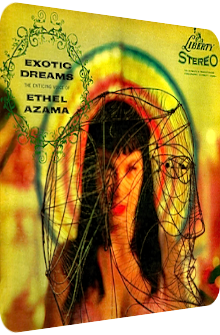
Ethel Azama
Exotic Dreams
1958
Which record is produced by Martin Denny, arranged by pianist Paul Conrad and features vintage Exotica's second lady who is only outclassed by the Peruvian chantress Yma Sumac? It's Exotic Dreams, released in 1958 that puts – so tells the cover artwork – "the enticing voice of Ethel Azama" (1934–1984), a Hawaiian Jazz singer, into the spotlight. With only two records in her discography and many guest entries, among them a vocal performance on Arthur Lyman's Exotica debut and second album overall, Taboo of the same year, she started her career at Oahu's Cannon Club where she was accompanied on the piano by Paul Conrad.
Martin Denny discovered her a few years later and was able to negotiate with his house label Liberty Records, which granted Azama the opportunity to release one LP on which Denny also provides the liner notes (on a side note, Jimmie Rodgers succeeded with his negotiations as well, granting Azama a contract for a second LP in 1959). Exotic Dreams is one of those superb records that live up to the hype due to both the beautiful voice of the singer and the exotic arrangement alike, causing the listener to execrate the missed opportunities of releasing further material, as Azama faded into obscurity shortly thereafter despite her obvious talent, various gigs in Hawaiian and Australian night clubs and her recurring role in the 70's TV series Hawaii Five-0.
Twelve songs are featured on Exotic Dreams, and the style ranges from Far Eastern mystique over Hawaiian snugness to faux-Polynesian exhilaration. Ethel Azama feels always at home, regardless of the tempo, style or mood, and once the listener is growing tired of the occasionally jazzy nature, the next song around the corner is totally different, yet cohesive enough to not tear the concept of dreaminess apart.
Fujio Ozawa's and Masao Yoneyama's Ringo Oiwake launches the album, one of the better-known and often considered songs in the Exotica genre. And sure enough does it start with one of the boldest Far Eastern flavors, as crunchy koto licks, darkly droning temple gongs, sparkling wind chimes and Asian tone sequences on the vibraphone are intertwined to form a resplendent eleven-note background for Ethel Azama to shine. Her voice sounds much younger and friendlier than Yma Sumac's; it is less melodramatic in order to boost the intimacy, but strong enough to not resemble fragility. It's a good start thanks to its memorable, if also deliberately streamlined melody.
What Ringo Oiwake lacks in complexity is delivered on the bongo side with the Latin/faux-Polynesian hybrid Two Ladies In De Shade Of De Banana Tree, a unique composition written by Harold Arlen with male chants, cheeky lyrics by Azama who sounds completely different than in the opener. It's a much brighter track with six-note themes on the glinting vibraphones and Conrad's sunny piano. The staccato trait makes this a lively track and results in one of Ethel Azama's best performances, totally convivial and care-free.
While Shady Lady Bird by Ralph Blame and Hugh Martin comprises of theremin-like whistles, hollow exotic percussion, mellow cymbals and Honky Tonk piano accents as well as a reprisal of the cheeky particles in Azama's voice (her da-ba-dah chants come to mind), John Latouche's Lazy Afternoon is fantastically interpreted, utterly dreamy thanks to its phantasmagoric temple gongs, incessantly glittering, raindrop-resembling wind chimes, warmly glowing piano chords and carefully slapped double bass accentuations. Ethel Azama's voice is true to form, the soft timbre expands the whirring mirage even further. A superb track and one of her all-time classics to remember her by.
Benny Carter's auspiciously titled Friendly Island – which is also featured on Don Tiki's third studio album South Of The Boudoir (2009) – enhances the strictly jazzy double bass setting with chirping birds, a downwards spiraling vibraphone breeze and super-mellow bamboo rod percussion, all of which whirr around Azama's happiness-injecting vocals, but it is Miklós Rózsa's and Jerry Brooks' Green Fire that tops off the majority of the material of side A thanks to the mystical-jocular ambiguity of the four-note piano motif that is played in many tone regions, carefully nurtured by bongo beats and the delicious vibrato of the iridescent vibe droplets. Azama's voice changes once again as she focuses on the magic of the green fire, being totally enchanted by it and delivering a performance that lives up to this mood.
Side B starts with a Hapa Haole song called Kawohikukapulani, originally composed by Helen Dasha Beamer. This is a fantastic piece of dreaminess in the veins of Beyond The Reef, Waipio and Whispering Reef Lullaby. The cozy vibraphone washes are accompanied by chirping birds, Paul Conrad's carefully played piano tercets and mellowly clicking sea shells. Azama sings in Hawaiian, catering to fans of this kind of music and performing a truly Polynesian song, quite a change to the fake nature of the genre.
Ogden Nash's and Kurt Weill's Speak Low is the rare dud with an off-putting piano skeleton and slightly better vibraphone gleams that are still too staccato-esque in their nature. The middle phase revs up the tempo to frantic dimensions, making this a rather strange intersection. Nothing is wrong with Azama's voice, but once the instrumental background is so lackluster, her performance is degraded, I'm afraid. Things get way better on the remarkable Mountain High, Valley Low. The koto, wind chimes and gelid mallet instrument return, and the galloping beat as well as the dripping xylophones in the second half augment the Japanese spirit of Bernie Hanighen's and Raymond Scott's composition of solemnity and grace further. It is the instrumental side that is important here, but Azama's voice is nonetheless able to sound well-integrated in this romantic ballad. This is another huge hit and one of my favorite Exotica songs which is also splendidly conducted on Warren Barker’s A Musical Touch Of Far Away Places, but can be found on numerous other genre-related albums as well.
The vibraphone glitz returns in full force on the intro of Oscar Hammerstein's and Richard Rodger's Happy Talk, but soon enough the jumpy bar piano melody takes over, transferring the song into jazzy regions, and Azama seems to be perfectly, well, happy to perform another jazzy song. Xavier Cugat's and George Rosner's Nightingale is another high point, as enigmatic vibe cascades and low-level piano chords are deliberately put in the back so that Azama's voice is more upfront than before, even the jazzy double bass-backed interlude followed by the savage bongo section don't change this. The final Autumn Leaves by Johnny Mercer leaves a lasting impression, as this eternal classic is seldom heard on an arcane koto. The mood is very nostalgic and sad. The doleful piano underlines this perception even further. If it wasn't for the koto, I'd dislike this gloomy composition, as it isn't at all a fitting conclusion to the previously soothing wonderlands, but its novelty factor is high enough in the end.
Ethel Azama can count on capable men on this album, and since she only delivered another work, Cool Breeze in 1959 full of Western Jazz interpretations, I can state without the slightest doubt that Exotic Dreams is her best work that lives up to the given promise in its title, as most of the material is either dreamy in a cozy or a mystical way. Paul Conrad makes sure that the album also harks back to the roots of Azama's career which started in Jazz clubs, hence the many scattered piano interludes and double bass accentuations on her release. I very much prefer the dreamy, vibraphone-fueled material, and there's plenty of it, Lazy Afternoon, Green Fire or Mountain High, Valley Low, to name just three compositions. Since Azama's voice is never too much on the forefront – I'm thinking of Yma Sumac – I believe that even fans of instrumental Exotica can enjoy many of the 12 vocal tracks on this LP.
As is the case with Sumac's albums, the instrumental range is as wide as the stylistic spectrum, but whenever Sumac starts to sing a note, it's usually quite a bit harder to grasp the shimmering beauty of the aural textures in the background. This is not a problem on Exotic Dreams, as Azama sings gently and innocently enough, allowing the piano and mallet instruments to shine on their own. Fans of Far Eastern melodies should check out Ringo Oiwake and surprisingly enough Autumn Leaves, as both feature a koto and temple gongs. Vibraphone lovers might want to own this proper Exotica release anyway (and already do, I bet). The thought of Paul Conrad arranging all of these compositions is a comforting one, as he himself is another forgotten talent of the genre and only resurfaced very recently due to the resurrection of the genre. Let's end this review with a rhyme to help you make a decision: Are you hating Sumac's drama, don't feel bad and take Azama. Thank you, thank you. ;-)
Exotica Review 111: Ethel Azama – Exotic Dreams (1958). Originally published on Aug. 25, 2012 at AmbientExotica.com.
